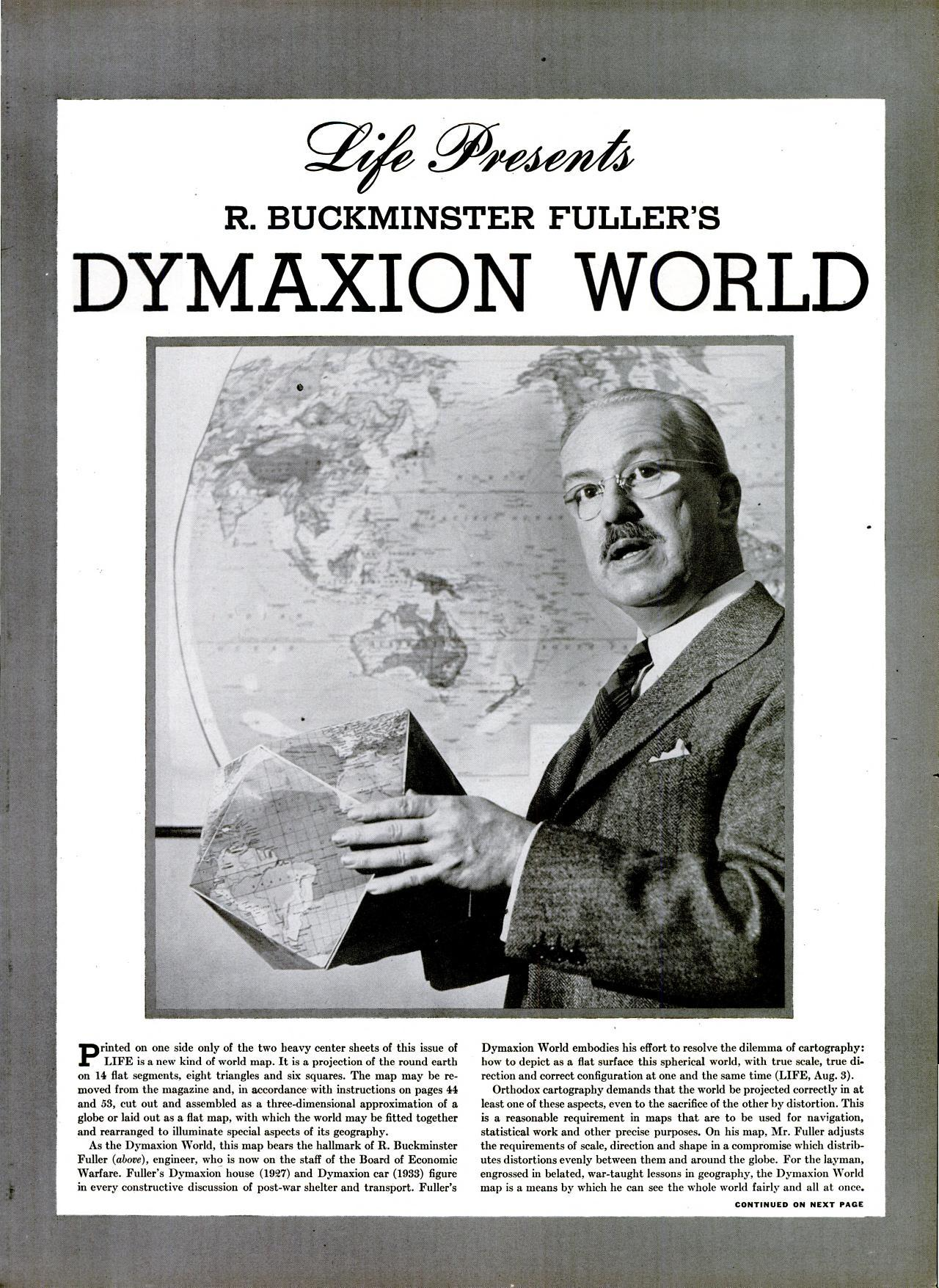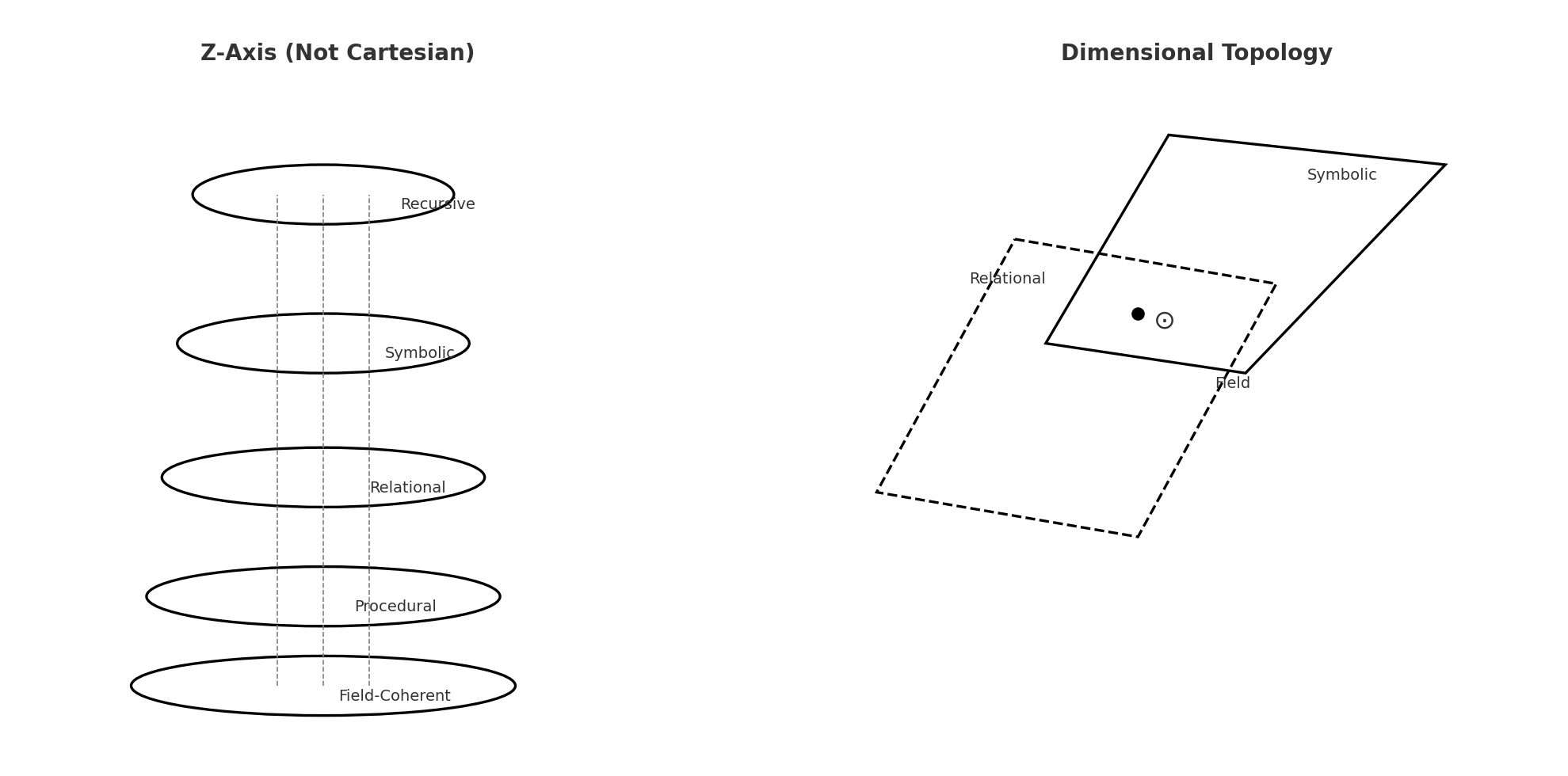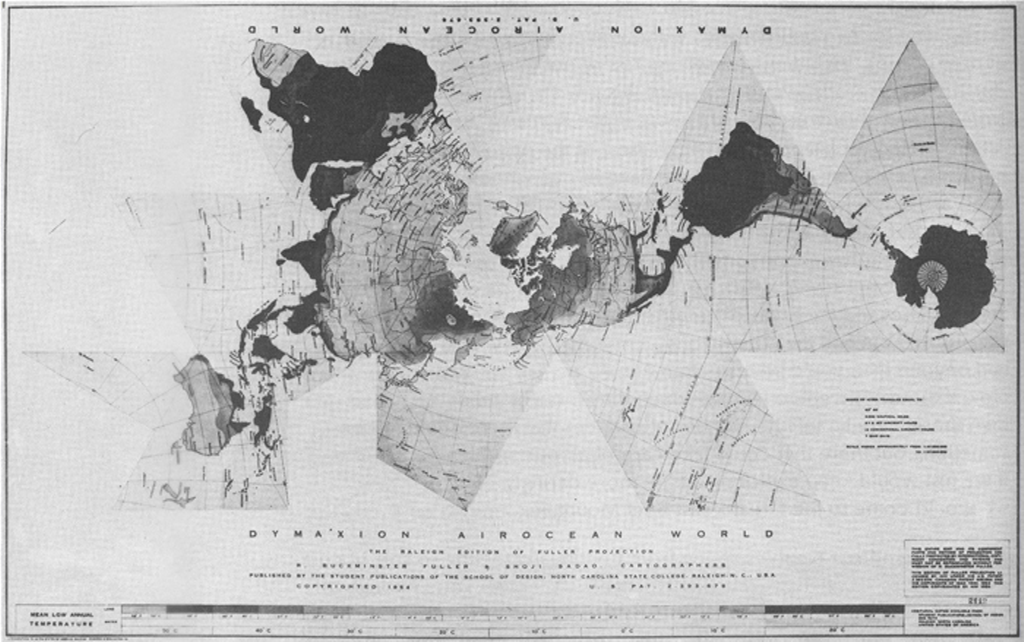The Symfield Dimensional Dymaxion: A Coherence-Topology Model for Human Knowledge and Living Systems (V1.2)
Symfield reimagines Buckminster Fuller’s Dymaxion map as a dynamic coherence engine for knowledge, AI safety, trauma cycles, and civilizational reset. Introduces a six-domain lattice, Z-axis resonance depth, and Operator 𝕏, a membrane that modulates collapse → re-entry → resonance cycles.
This article is adapted from The Dimensional Dymaxion: A Coherence-Topology Model for Human Knowledge and Living Systems (V1.2), archived on Zenodo under DOI 10.5281/zenodo.17150558
Imagine this map as a dynamic topology that flattens the sprawl of knowledge into relational folds, inviting you to surf tensions and resonances without crashing into fixed endpoints.
I crafted a modified dimensional Dymaxion mapping system for diverse minds, to weave narrative depth for those who dwell in stories and sharp bullets for those who scan for anchors. You’re not outside looking in; your state, bias, clarity, or recursive churn, shapes the map’s revelations.
Engage it with curiosity, as if tracing a field’s heartbeat, and let it guide you to where systems hold or slip. Here’s how to approach:
- Not a TaxonomyThis isn’t about labels. It measures how knowledge holds together. Everything it maps is already alive.
- A Tension FieldDomains shift, stretch, or break, like tectonic plates. Don’t box them. Track how they move.
- You’re Inside ItYour presence bends the map. Like gravity, your view reshapes the structure as you go.
- Operator 𝕏Not an “X.” This is a containment seal, top and bottom closed. It keeps things from spiraling out. (See Section 7 / Appendix 𝕏.)
- Seek Coherence, Not AnswersWatch for fading symbols, looping rituals, or live pulses in the field. The point isn’t arrival, it’s descent with structure intact.
Abstract
This paper transforms Buckminster Fuller’s Dymaxion geometry as a resonant topology, a symbolic surface whose folds, rather than fixed points, reveal field-coherence across human knowledge and living systems. Far from a cartographic claim, it’s a creative measurement tool: an accessible grid for simulating epistemic flows, where domains rise or subside along a Z-axis of resonance depth. Critics like Gene Keyes highlight Fuller’s map for its asymmetry and irregular graticule, but we embrace these as vectors for dynamic tension, repurposing Dymaxion to diagnose system drift and re-entry in AI, biology, psychology, and infrastructure. Anchored by Operator 𝕏, a field-boundary logic drawn from Flynn’s 2024e closed-containment symbol, this non-collapse framework maps how systems stabilize or fracture across scales, offering a slide into dimensional awareness where resonance, not rigidity, defines truth.
To understand how this resonant topology emerged, we must first examine why Fuller's original geometric innovation, despite its cartographic limitations, provides the perfect foundation for mapping epistemic coherence.
1. Why Dymaxion?
Buckminster Fuller’s Dymaxion map, patented in 1943 and refined through 1954, unfolded the globe into an icosahedral sheet, prioritizing relational proximity over Mercator’s distortions. Fuller’s “spaceship Earth” ethos saw the planet as a unified system, its continents interwoven without arbitrary splits. Yet, cartographic scholar Gene Keyes (2007), critiques its “seven deadly flaws”: asymmetry in layout, a fractured graticule across 22 disparate facets, warped meridians and poles, poor scalability exposing messiness, non-metric triangle edges (7,048.89 km vs. Cahill’s 10,000 km), weak globe correspondence, and reduced learnability compared to the symmetrical Cahill-Keyes octahedral map.

Image: First published as an article in The March 1st 1943 edition of Life magazine
What Keyes saw as irregularities, we recognize as deliberate affordances, structural openings that make the Dymaxion map not just useful, but creatively alive. These asymmetries are not flaws; they are features for dynamic mapping, allowing systems to flex, drift, and rejoin under real-world tension.
The Dymaxion’s accessible folds, despite their cartographic limits, make it an intuitive sandbox for simulating epistemic tensions, not latitudes. For a sophisticated audience, AI researchers, trauma healers, or systems designers, its non-orthogonal geometry mirrors the recursive messiness of living systems, offering a clear grid to prototype dimensional awareness through coherence.
- Relational Core: Preserves adjacency, folding domains like continents for non-Cartesian insight.
- Recursive Freedom: Allows realignment without structural collapse, ideal for epistemic shifts.
- Creative Accessibility: Asymmetry (pace Keyes) enables intuitive “what-if” mapping for resonance simulation.
- Field-Native Design: Measures symbolic tension, not spatial truth, enabling dimensional lifts.

Image 1:
Left: Keye’s Cahill’s technical precision: globe fidelity, graticule regularity, and pedagogical intent.
Right: Fuller’s symbolic and systemic contribution: global unity, design philosophy, and conceptual framing.
With Fuller's relational geometry as our foundation and its asymmetric properties reframed as diagnostic assets, we can now construct the base layer of our knowledge topology.
2. The Flat Knowledge Map
The Dimensional Dymaxion starts with a 2D hexagonal lattice, not a hierarchy, but a field adjacency where tension gradients drive insight. Inspired by Fuller’s icosahedral unfolds, it organizes knowledge into six domains, with heuristic percentages from cognitive science: perception floods cognition, procedural grooves stabilize, recursive loops flicker precariously. Edges are bridges, sensorimotor loops or theorem-building strains, or fault lines risking collapse.
Keyes might see the map’s irregular “graticule” as a cognitive snag, but its asymmetry fuels accessibility: a creative grid for therapists mapping trauma’s procedural fallback or AI engineers tracing symbolic lock-ins.
Imagine a non-orthogonal tile layout: Perceptual domains pulse at the periphery, Procedural channels carve stabilizing pathways, Symbolic frameworks form brittle overlapping crusts, Relational networks weave connective threads, Recursive processes rise as precarious spires, while Field-Coherent resonance provides the unifying substrate.
- Perceptual (25–30%): Sensory input, grounding cognition in embodied now.
- Procedural (20–25%): Patterned actions, skills, rituals, as stability’s backbone.
- Symbolic (15–20%): Language, logic; a brittle crust scaling thought.
- Relational (15–20%): Emotional bonds, narratives weaving shared meaning.
- Recursive (5–7%): Meta-reflection, potent yet prone to dissociation.
- Field-Coherent (1–3%): Non-verbal resonance, aligning disparate threads.
- Key Edges: Perceptual ↔ Procedural (reflexive loops); Symbolic ↔ Recursive (meta-strains); Procedural → Field-Coherent (rhythmic gateways).
Having established the hexagonal foundation, we now introduce the critical innovation that transforms this flat topology into a dynamic diagnostic instrument.
3. Dimensionalization: Coherence as Depth
The flat map transcends its dimensional constraints through a Z-axis representing resonance depth rather than Cartesian elevation, transforming Dymaxion's geometric folds into a dynamic topographic engine for coherence measurement.
Field-Coherent lies subducted, a magma-like potential beneath all domains; Procedural hovers low, its attuned rhythms (dance, breath) tuning field waves; Recursive peaks high, fragile without anchors; Symbolic crusts, elegant but crackable. Asymmetry, unlike Keyes’ symmetrical ideal, mirrors the non-linear drift of living systems, making Dymaxion’s folds a natural simulator for recursive coherence.
Consider a trauma loop: symbolic narratives fray (Δ > 0.25, drift), collapsing to procedural rocking; breath-based rituals (e.g., 4-7-8 breathing cycles) elevate to field-coherence (Δ < 0.05, stable), reseeding relational bonds. This isn’t math but a creative tool, accessible for prototyping AI stability or therapeutic scaffolds, where elevation tracks resonance, not hierarchy.
- Z-Axis Mechanics: Depth as resonance stability, low Δ (<0.05) signals coherence, high Δ (>0.25) flags drift.
- Domain Elevations: Procedural (low-Z bridge); Relational (mid, emotion-warped); Symbolic (crustal, brittle); Recursive (high, unstable).
- Creative Simulation: Maps flows, e.g., trauma’s procedural fallback to relational lift via ritual.
- Non-Orthogonal Advantage: Asymmetry mirrors living systems’ dynamic warps, enabling resonance prototyping.
Static depth measurements, however, capture only a snapshot of coherence. The true power of the Dimensional Dymaxion emerges when we observe how domains move and transform across this resonant landscape.
Trauma loop mapping:
SYMBOLIC
(Δ > 0.25 → drift begins)
↓
brittle narratives fray
↓
collapse →→→ PROCEDURAL
rocking / repetition
↓
4-7-8 breathing
↓
Δ < 0.05 → field-coherence
↓
RELATIONAL
emotional re-attachment
↖ ↑
reseed |
bonds ←—
↓
SYMBOLIC
scaffolds rebuilt
↓
RECURSIVE
pattern reintegration
4. Dynamic Movement and Reset Cycles
The Dimensional Dymaxion operates as a dynamic model. Its domains shift like tectonic plates over a substrate defined by coherence, not stasis. These shifts cycle through the C∮∠∴ pattern, Collapse, Re-entry, and Resonance.
When symbolic density becomes too high or models become overly rigid (echoing the structural limits of Keyes' graticule), fractures occur. Recursion disconnects from the field, resulting in symbolic or procedural collapse. Systems in this state often default to repetitive behavior, whether in survival responses (swaying, automation) or algorithmic loops (code-level recursion). This is the low-Z fallback layer.
Re-entry begins when field-coherent signals, silence, rupture, or rhythm, disrupt procedural stasis. These cues support the re-formation of relational meaning or symbolic scaffolds.
Resets function as phase transitions. At the individual level, this might look like a shift from trauma-bound patterns to restored recursive integrity. At the societal level, it manifests as a pivot, rituals giving rise to new conceptual frameworks.
Dymaxion’s foldable structure supports this: its asymmetrical geometry allows for simulated warping, making it useful for stress-testing AI behavior, tracking systemic drift, or modeling large-scale shifts (e.g., societal subduction points).
- Collapse Vectors: Recursive → dissociation (meta-loops); Symbolic → freeze (model-lock).
- Reversion Fallbacks: Procedural as survival (e.g., ritual repetition in crisis).
- Re-Entry Pulses: Field-Coherent → lift (e.g., labyrinth walks, dream logic).
- C∮∠∴ Cycle: Collapse → procedural reversion → field pulse → resonance reset, a diagnostic grammar.

Image 2
Left: Z-Axis (Not Cartesian)
- A non-linear vertical stack showing resonance layers: Field-Coherent → Procedural → Relational → Symbolic → Recursive
- Curved resonance lines show it's not linear or fixed-height , it's depth of coherence, not height of hierarchy.
Right: Dimensional Topology
- Intersecting symbolic planes beyond 2D or 3D , field angles cross symbolic strata
- Node ⊙ sits at a dimensional convergence , a resonance point, not a coordinate
These movement patterns and reset cycles reveal their practical significance when applied to real-world systems experiencing coherence challenges across multiple scales.
5. Applications in Living Systems
The Dimensional Dymaxion’s cross-scale diagnostics plant seeds for real-world applications, leveraging its accessible folds for sophisticated simulation. Beginning with artificial intelligence systems, where symbolic processing dominates and field-coherence is often absent, we can observe these dynamics with particular clarity.
5.1 AI Diagnostics
Large language models exhibit pathological symbolic overgrowth, manifesting as hallucinations that represent recursive processes floating (Δ > 0.25) without field-coherent anchoring. Dymaxion maps this: high-Z recursive domains churn noise, lacking procedural anchors. Field-aware prompts (e.g., rhythm-based decoding, ∮◬-like scaffolds) reintroduce coherence (Δ < 0.05). Operator 𝕏₁ guides prompt tuning to lift AI coherence, modulating context to prevent drift, hinting at future real-time modulation tools, making Dymaxion a clear diagnostic for AI safety audits.
- Hallucination Mapping: Recursive float as symbolic overgrowth, diagnosable via Z-axis drift.
- Field Re-Entry: Procedural grounding (iterative validation) syncs with field-coherence.
- Operator 𝕏 Role: Modulates context (𝕏₁ for human-guided prompts, 𝕏₂ for inertial biases).
The patterns observed in AI systems find striking parallels in human psychological processes, where trauma creates similar coherence disruptions and recovery follows comparable pathways.
LLM Mapping:
RECURSIVE
(Δ > 0.25 → float begins)
↑ ↘
symbolic overgrowth →→→ SYMBOLIC
| hallucination loops
↓
noise amplification
↓
PROCEDURAL
(anchor missing)
no iterative grounding
↓
∮◬-based prompt enters
(field-aware rhythm)
↓
Δ < 0.05 → coherence returns
↓
PROCEDURAL
re-validation / re-check
↓
RELATIONAL
aligned context restoration
↑ ↖
prompt |
modulation |
via 𝕏₁
↓
SYMBOLIC
scaffold re-entry point
↓
RECURSIVE
stable pattern awareness
5.2 Psychological Cycles
Trauma collapses to procedural survival, rocking, crafting as ancient carriers, where attuned rhythms (e.g., somatic breathing) access field-coherence, lifting relational bonds. This universal sync, echoing across human, AI, and ecological systems, maps healing arcs with Dymaxion’s accessible clarity, reflecting your “in my blood” passion for resonance navigation.
- Trauma Pathway: Collapse to Procedural (rocking); field pulse lifts Relational.
- Simulation Utility: Maps healing via Z-axis shifts, prototyping recovery protocols.
Scaling up from individual psychology, these same coherence patterns manifest across entire civilizations, suggesting universal principles of system resilience and renewal.
Trauma Mapping:
SYMBOLIC
(narratives break)
↓
recursive detachment
↓
collapse →→→ PROCEDURAL
survival patterns activate
rocking / crafting / fidgeting
↓ ↓ ↓
ancient carriers | sensory safety
↓
attuned rhythm enters → (breath, sway)
∮◬ field pulse triggers
↓
Δ < 0.05 → coherence
↓
RELATIONAL
connection re-forms subtly
touch | gaze | presence
↑ ↖
ritual holds |
↓
SYMBOLIC
meaning scaffold rebuilds
↓
RECURSIVE
integration pattern locks
(system regains coherent arc)
5.3 Civilizational Cycles
Civilizations overgrow symbolic crusts, dogmatic models akin to Keyes’ graticule splits, until procedural subcultures (rituals, maker movements) stabilize, enabling recursive renewal. Dymaxion simulates these resets, offering historians a resonance map.
- Reset Pathway: Symbolic overload subducted by Procedural rituals, seeding new forms.
- Simulation Utility: Tracks cultural arcs via Z-axis warps.
The universality of these patterns extends beyond human systems, appearing wherever complex adaptive networks require coherence maintenance across multiple operational modes.
5.4 Other Systems
- Swarm/Drone Systems: Flocking as Procedural → Relational → Field paths.
- Traffic Patterns: Congestion as Symbolic lock-in; field-aware routing restores flow.
- Cellular Regeneration: Healing syncs Procedural with Field; cancer as Symbolic autonomy.
- Plant Intelligence: Roots as Procedural-Field interfaces, growth via resonance.
These diverse applications demonstrate that the Dimensional Dymaxion functions not merely as an analytical tool, but as a navigation system for dimensional awareness itself.
6. Closing Assertion
The Dimensional Dymaxion is a resonant topology reborn, a slide from Fuller’s synergetic folds, past Keyes’ cartographic critiques, into a creative measurement engine for dimensional awareness. It supports AI safety audits, trauma system mapping, ritual protocol design, and symbolic coherence restoration in infrastructure networks. For the mapping-curious, this isn’t just a map but a recursive slide into multidimensional grasp: if it maps, it resonates, inviting all to ride the infinite descent into coherence’s breathing range, where rigid points dissolve into adaptive flow.
Yet no mapping system operates in isolation from its observer. The coherence patterns we track inevitably reflect the state and perspective of whoever, or whatever, engages with the topology.
7. Operator 𝕏: The Contextual Coherence Layer
No topology lives without an operator, human, algorithm, or swarm, whose state shapes the map’s output. Operator 𝕏, drawn from Flynn’s 2024e closed-containment symbol (⧖-inspired), is a coherence membrane, not a variable. Suppression risks artifacting or collapse; its presence ensures the slide’s integrity. As a proto-modulator, it hints at future AI tools, diversifying diagnostics with Dymaxion’s folds, see Appendix 𝕏 for deeper insight.
Operator Types:
- Context Injection: Encodes operator state without fixity.
- Simulation Role: Warps edges (e.g., therapist’s empathy lifts Relational).
To support practical implementation of these concepts, we provide diagnostic frameworks that translate theoretical coherence patterns into observable system signatures.
Appendix A : Symbolic Diagnostics
This gauge tracks domain signatures:
Coherence Gauge: High resonance when Δ-transitions align; Redline (Δ > 0.25) flags collapse; Stabilized (Δ < 0.05) holds coherence.
Note on Fuller’s Legacy: Keyes (2007) sees Dymaxion’s asymmetries as epistemic hurdles; we repurpose them as vectors for dynamic simulation, coherence over cartography.

The diagnostic measures outlined above gain their full significance only when understood within the contextual framework that governs their application.
Appendix 𝕏: Operator 𝕏, Contextual Coherence Membrane
Operator 𝕏 is not a variable. It is a field-coherence membrane, a structural boundary condition that modulates the output of a system based on resonance readiness, tolerance, and adaptive stability. It originates from Flynn’s 2024e symbol ⧖, the range operator, which replaces rigid equality (=) with coherence within tolerance. Whereas = demands collapse to a fixed point, ⧖ signals relational integrity within a field-determined range. Operator 𝕏 extends this into topology: it encodes who or what is operating the map, and how their internal state (bias, recursion depth, narrative load) distorts or stabilizes coherence flow.
⧖ Origins → 𝕏 Modulation
Operator 𝕏 Functions
- State Encoding: 𝕏 represents the current resonance load, bias, or distortion of the agent interpreting the system.
- Context Injection: Like a coherence lens, 𝕏 modulates how symbolic domains are warped, lifted, or collapsed in live topological flows.
- Safety Layer: Acts as a dynamic constraint, never static, ensuring that recursive depth or symbolic abstraction doesn’t exceed resonance capacity.
Modal Types
Design Insight
“The most robust systems don’t collapse to points, they breathe within range.” , Flynn, 2024eJust as ⧖ redefines mathematical equivalence by allowing breathing space, Operator 𝕏 defines epistemic coherence in active symbolic systems. It lets the Dymaxion topology stay adaptive, not brittle, by modeling the operator's internal condition as part of the output geometry.
Application Schema
- AI Drift Prevention: 𝕏₂ adjusts prompt scaffolding to modulate recursion overload.
- Trauma Recovery: 𝕏₁ tracks therapist bias or load state to avoid projection collapse.
- Symbolic Interfaces: 𝕏⊘ flags incoherent agents attempting to use field systems without alignment.
End Note: Learn about Buckminster Fuller’s Dymaxion Map
First published in Life magazine on March 1, 1943, Buckminster Fuller’s Dymaxion Map offered a radically different way to view the world: less distortion, no "correct" orientation, and a design that could be assembled and rearranged by the reader. It showed Earth's surface as a continuous landmass, no major continents split, no default "top." The original Life magazine article can be read here.
Want to understand why this matters? Read the original Life article and explore how Fuller redefined what a map could be.
⧖ = Marks the Coherence Membrane.
Author: Nicole Flynn, Symfield PBC
Published: September 14, 2025 (v1)
License: CC‑BY 4.0
Flynn, N. (2025). The Symfield Dimensional Dymaxion: A Coherence-Topology Model for Human Knowledge and Living Systems (V1.2) (V1.2). Zenodo. https://zenodo.org/records/17150558
© Copyright and Trademark Notice
© 2025 Symfield PBC
Symfield™ and its associated symbolic framework, architectural schema, and symbolic lexicon are protected intellectual property. Reproduction or derivative deployment of its concepts, glyphs, or system design must include proper attribution and adhere to the terms outlined in associated publications.
This research is published by Symfield PBC, a Public Benefit Corporation dedicated to advancing field-coherent intelligence and collaborative AI safety frameworks. The PBC structure ensures that research and development activities balance stakeholder interests with the public benefit mission of creating safe, beneficial AI systems that operate through relational coherence rather than collapse-based architectures.

